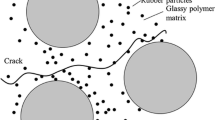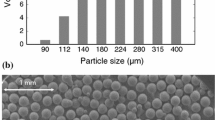Abstract
The plastic deformation and fracture of aluminium hydroxide filled polypropylene has been investigated. A transition between two mechanisms with an increase of the filler volume fraction has been observed. Below a critical filler volume content φcr ≈ 20 vol% (designated region 1) adhesive failure processes and polymer deformation in the neighbourhoods of different particles occur in an uncorrelated manner. Above this critical value (designated region 2) exfoliation along the surface of the initial portion of inclusions causes the formation of craze-like deformation zones transverse to the direction of the loading. The concentration of craze-like zones is essentially determined by the filler content and the level of interphase interaction which in turn depends on the particle size. In region 1 deformation occurs in a macro heterogeneous way with the formation and growth of a neck. The elongation to break decreases with an increase in the mean diameter of the filler phase. At φ>φcr composites, filled with small particles, fail in quasi brittle manner with the formation of a short and narrow neck. In contrast to the case for a small filler concentration, an increase of the inclusion size leads to an increase in the ultimate elongation and a tendency to macro homogeneous yielding. An explanation of the observed behaviour is proposed based on a change in adhesive failure conditions with filler content and size.
Similar content being viewed by others
References
L. E. NIELSEN, “Mechanical Properties of Polymers and Composites”. (Marcel Dekker, New York, 1974).
N. V. GORBUNOVA, N. N. KNUNYANTZ, V. A. TOPOLKARAEV, L. I. MANEVICH and V. G. OSHMIAN,Mekhanika Kompoz. Mater. (1990) 336.
V. A. TOCHIN, E. N. CSCHUPAK, V. V. TUMANOV, O. V. KULACHINCKAYA and M. I. GAY,ibid. (1984) 635.
I. L. DUBNIKOVA, A. I. PETROSYAN, V. A. TOPOLKARAEV, YU. M. TOVMASYAN, I. N. MESCHKOVA and F. S. D'YACHKOVSKII,Vysokomol. Soyed. A30 (1988) 2345.
V. A. TOPOLKARAEV, N. V. GORBUNOVA, I. L. DUBNIKOVA, T. V. PARAMZINA and F. S. D'YACHKOVSKII,ibid. A32 (1990) 2210.
I. L. DUBNIKOVA, V. A. TOPOLKARAEV, T. V. PARAMZINA, E. V. GOROKHOVA and F. S. D'YACHKOVSKII,ibid. A32 (1990) 841.
M. PEGORARO, A. PENATY, E. CAMMARATA and M. ALIVERTI, in “Polymer blends: Process, Morphology and Properties” (Plenum, New York 1984) Vol. 2, p. 205.
V. A. TOPOLKARAEV, YU. M. TOVMASYAN, I. L. DUBNIKOVA, A. I. PETROSYAN, I. N. MESCHKOVA, A. A. BERLIN, YU. P. GOMZA and V. V. SCHILOV,Mekhanika Kompoz. Mater. (1987) 616.
N. N. KNUNYANTZ, A. V. ZHUK, V. G. OSHMIAN, V. A. TOPOLKARAEV and A. A. BERLIN,Mackromol. Chem.,Macromol. Symp. 44 (1991) 295.
A. V. ZHUK, N. N. KNUNYATZ, V. A. TOPOLKARAEV, V. G. OSHMIAN and A. A. BERLIN,J. Mater. Sci. 28 (1993) 4595.
V. G. OSHMIAN,Mekhanika Kompoz. Mater. (1992) 34.
I. L. DUBNIKOVA, E. V. GOROKHOVA, A. YA. GORENBERG, V. A. TOPOLKARAEV,Vysokomol. Soyed. A37 (995) p. 1535.
Author information
Authors and Affiliations
Rights and permissions
About this article
Cite this article
DUBNIKOVA, I.L., OSHMYAN, V.G. & GORENBERG, A.Y. Mechanisms of particulate filled polypropylene finite plastic deformation and fracture. Journal of Materials Science 32, 1613–1622 (1997). https://doi.org/10.1023/A:1018547226983
Published:
Issue Date:
DOI: https://doi.org/10.1023/A:1018547226983




